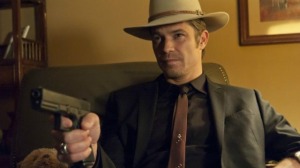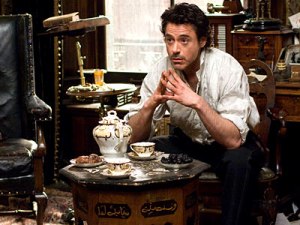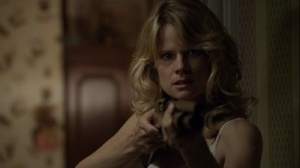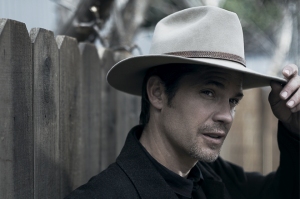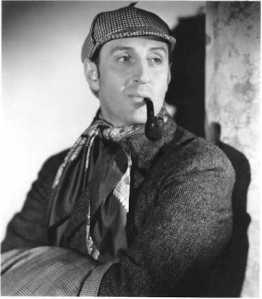A funny thing happened on the way to me clicking my Amazon Prime “next episode” button. I was binge-watching (as you do) the FX series Justified, when I realized something. Gun-toting, cowboy-hat-wearing, cerebral US Marshall protagonist Raylan Givens isn’t all that different from Sherlock Holmes underneath all those western trappings. Justified is a modern, stylized Western series derived from the classic works of Western authorial legend Elmore Leonard (who penned 3:10 to Yuma and whom I, regrettably, have yet to read. However, he gave his absolute blessing to the show and to actor Timothy Olyphant’s portrayal of Givens, so I feel comfortable comparing the character with Holmes across the literary and TV genres.
Like Holmes, Givens is undeniably an introvert, someone who is well nigh impossible for strangers to get a read on and whose friends and loved ones often struggle to understand. He’s also someone who, like Sherlock, is constantly hyper aware of his surroundings and often puts together major chains of reasoning using minuscule clues. Another similarity, one that is often overlooked in Holmes’s character, is a wry sense of humor that takes delight in the absurdities of the human condition.
When it comes to interactions, Raylan’s friendships are very few and very meaningful. Though he doesn’t exactly have a Watson, he certainly has a Moriarty, in the form of friend-turned-archenemy Boyd Crowder. He also, arguably, has an Irene Adler in the character of the beautiful, unstable Ava Crowder, who is alternately friend and foe, sometimes both at the same time.
Perhaps even more significantly, both characters share an internal moral code that doesn’t always dovetail with the perspective of official law enforcement. In Milvertonian style, what kicks off the series “Justified” is Givens unhesitatingly dispatching a crook with his admirable fast draw. Holmes is, of course, well known for taking the law into his own hands both to exact mercy and justice.
In the superficial sense, or perhaps not quite so superficial as it originally seems, is the characters’ shared penchant for hat wearing. In Givens’s case, he’s frequently seen wearing a 10-gallon, beige, felt cowboy hat, regardless of the fact that he’s neither around other hat wearers nor anywhere near the West. When asked why, he simply says, “I tried it on one day, and it fit.” In similar unwitting style, Holmes’s character has become identified with the deerstalker in a way that doesn’t reflect its (lack of) presence in the canon but is now inseparable from the image of who Holmes is. The reason I quibble with the idea that either man’s hat is an insignificant detail is because of what the overall idea of hat wearing symbolizes in both characters. For Givens, a cowboy hat is entirely out of context in his circumstances but is somehow brought into context by its integration into his own personality. In a similar sense, a deerstalker hat isn’t a common fixture in Victorian London, but its presence in the persona of Sherlock Holmes gives it pride of place. For each character, hat wearing seems to symbolize a lack of caring one whit what anyone else thinks about his personal choices, as long as they integrate with his own internal view of himself.
To what does all this tend? While it’s an interesting academic exercise to compare Holmes with other characters, there’s more to it than that. Raylan Givens isn’t just a single, original character; he’s emblematic of the very idea of the iconic Western hero–resolute, self-directed, wryly humorous, and starkly brave. As I began to compare him to Holmes, I realized just how much literature’s (and screen’s) greatest detective has in common with the great heroes of the Western genre, the creations of Leonard and Louis L’Amour and the iconic portrayals of actors like Gary Cooper and John Wayne.
Sure, the trappings are different. Holmes doesn’t drawl, and he doesn’t practice his fast draw (though the scene in which he proves his strength by bending a fire poker could be straight out of any Western). He’s not usually confronting mustachioed villains in black hats. And yet, there’s something so very similar in the way characters like Marshall Will Kane, the lonely hero of the classic High Noon, quietly go about their larger-than-life business and the way Holmes goes about being the one man who can make London safe. They’re vigilantes, in a way, but it’s more than that.
Westerns, generally, are about an impossible task and the one man (or sometimes group of men) who can accomplish it. They share some kinship with superhero tales, but in another sense, they’re the opposite. They’re not about fanfare and fame’ they’re about duty–the job, the man, and the way he accomplishes the thing no one else is capable of doing. That’s exactly what the Holmes stories are about, too. People often want to make Holmes a superhero, and I understand the connection and have argued for it myself at times, but really, he’s far too quiet for that. He’s about getting the job done and riding into the sunset before the congratulations get too maudlin. Raylan Givens (and his fellow Western heroes) recognize that their abilities dictate their purposes. They can, so they do; it’s that simple. People often wonder about Sherlock Holmes’s motivations, but really, it comes down to that. He knows what he can do, and he does it, his purposes dictated by his incredible abilities.
There’s a scene that takes place fairly early in “Justified,” when Givens risks life and limb to rescue Ava from a kidnapper. The situation turns convoluted, but both of them eventually escape.
“Thank you,” says Ava.
“For what?” Givens asks.
For what, indeed. For Raylan Givens, WIll Kane, and any Western hero worth his salt, saving the good people and dispatching the bad is a job–often an epic-scale, Herculean task–but when the day is done and he’s knocking back a drink, he can smile wryly because it’s all in a day’s work and a duty completed. Reminds me quite a bit of the man who finishes the most epic feats of reasoning and bravery by filling his pipe, sitting down by the fire, and putting his feet up in 221b Baker Street.
See, the greatest heroes aren’t the ones who show you the sweat, blood, and tears or ask for the public accolades. They’re the ones telling you the tale with a half-smirk once the dirty work is done, as if it was all nothing. At least, that’s what Sherlock Holmes would have you believe. Not that he’d ever let you call him a hero, and I’m pretty well sure Raylan Givens wouldn’t either.
How to get my newest book:
(Book 3) The Detective The Woman and The Silent Hive is available from all good bookstores including Amazon USA, Amazon UK, Waterstones UK, and for free shipping worldwide from Book Depository. In ebook format it is in Amazon Kindle.
How to get the previous two books in the series:
(Book 1) The Detective and the Woman: A Novel of Sherlock Holmes is available from all good bookstores and e-bookstores worldwide including in the USA Amazon,Barnes and Noble and Classic Specialities – and in all electronic formats including Amazon Kindle , iTunes(iPad/iPhone) and Kobo.
(Book 2) The Detective, The Woman and The Winking Tree: A Novel of Sherlock Holmes is available from all good bookstores and e-bookstores worldwide including in the USA Amazon,Barnes and Noble and Classic Specialities – and in all electronic formats including Amazon Kindle , iTunes(iPad/iPhone) and Kobo.

